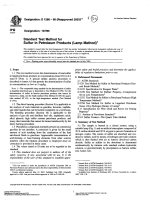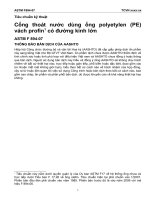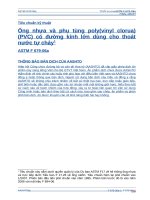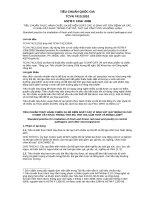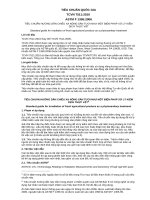Astm f 1317 98 (2012)
Bạn đang xem bản rút gọn của tài liệu. Xem và tải ngay bản đầy đủ của tài liệu tại đây (60.33 KB, 2 trang )
Designation: F1317 − 98 (Reapproved 2012)
Standard Test Method for
Calibration of Microwave Ovens1
This standard is issued under the fixed designation F1317; the number immediately following the designation indicates the year of
original adoption or, in the case of revision, the year of last revision. A number in parentheses indicates the year of last reapproval. A
superscript epsilon (´) indicates an editorial change since the last revision or reapproval.
1. Scope
3.3 Thermometer, readable to 60.5°C.
1.1 This test method is applicable to microwave ovens
designed for both home and commercial use. It was developed
for use in the evaluation of volatile and nonvolatile components of microwave susceptor packages.
3.4 Stopwatch.
4. Procedure
4.1 Using the stopwatch, check the accuracy of the microwave oven timer. Timer should be accurate to within 2 %. If
not, determine the settings necessary to ensure accuracy.
1.2 This test method was collaboratively evaluated with
microwave ovens with nominal output ratings of 700 W.
1.3 This standard does not purport to address all of the
safety concerns, if any, associated with its use. It is the
responsibility of the user of this standard to establish appropriate safety and health practices and determine the applicability of regulatory limitations prior to use.
4.2 Fill a 2 L beaker with exactly 1000 mL of distilled water
at 18 to 20°C. Record initial temperature of the water as T1.
4.3 Remove the thermometer and place the beaker in the
center of the microwave oven. If the oven has been used
recently, allow it to cool until it is at room temperature.
2. Referenced Documents
4.4 Microwave at full power for 2 min 3 s. The additional 3
s is to allow for the magnetron start up delay.
2.1 ASTM Standards:2
E691 Practice for Conducting an Interlaboratory Study to
Determine the Precision of a Test Method
F874 Test Method for Temperature Measurement and Profiling for Microwave Susceptors
F1308 Test Method for Quantitating Volatile Extractables in
Microwave Susceptors Used for Food Products
F1349 Test Method for Nonvolatile Ultraviolet (UV) Absorbing Extractables from Microwave Susceptors
F1500 Test Method for Quantitating Non-UV-Absorbing
Nonvolatile Extractables from Microwave Susceptors Utilizing Solvents as Food Simulants
F1519 Test Method for Qualitative Analysis of Volatile
Extractables in Microwave Susceptors Used to Heat Food
Products
4.5 Immediately after the power cycle completion, immerse
the thermometer in the water and vigorously stir. Measure the
temperature of the water. Record this temperature as T2 .
4.6 Repeat the measurements to obtain triplicate measurements of the temperature rise.
4.7 Once calibrated, this oven can be used for analytical test
standards such as Test Methods F874, F1308, F1349, F1500,
and F1519.
4.8 Recalibrate oven daily.
5. Calculation
5.1 Calculate the output, O, of the microwave oven in watts
using the following formula:
3. Apparatus and Reagents
O 5 34.9 ~ T 2 2 T 1 !
3.1 Microwave Oven, as manufactured.
3.2 Beakers, 2 L. (Alternatively use a 2-L polystyrene foam
container.)
where:
T1 = initial temperature of the water,° C, and
T2 = final temperature of the water, °C.
1
This test method is under the jurisdiction of ASTM Committee F02 on Flexible
Barrier Packaging and is the direct responsibility of Subcommittee F02.15 on
Chemical/Safety Properties.
Current edition approved Nov. 1, 2012. Published November 2012. Originally
approved in 1990. Last previous edition approved in 2007 as F1317 – 98 (2007).
DOI: 10.1520/F1317-98R12.
2
For referenced ASTM standards, visit the ASTM website, www.astm.org, or
contact ASTM Customer Service at For Annual Book of ASTM
Standards volume information, refer to the standard’s Document Summary page on
the ASTM website.
5.2 Average the three output values and use this mean as the
calibrated output wattage of the microwave oven.
6. Report
6.1 Report the following information:
6.1.1 Mean and standard deviation of these values for
output wattage of the microwave oven.
Copyright © ASTM International, 100 Barr Harbor Drive, PO Box C700, West Conshohocken, PA 19428-2959. United States
1
F1317 − 98 (2012)
intended to present a meaningful way of considering the
approximate precision of this test method.The data in Table 1
should not be rigorously applied to acceptance or rejection of
microwave ovens, as those data are specific to the round robin
and may not be representative of other conditions. Users of this
test method should apply the principles outlined in Practice
E691 to generate dataspecific to their laboratory and materials,
or between specific laboratories. The principles of 7.2-7.2.2
would then be valid for such data.)
7.2 Concept of RSr and RSR:
7.2.1 If RSr and RSR have been calculated from a large
enough body of data, and for test results that were test values
from testing individual specimens:
7.2.2 Relative repeatability RSr compares two test results for
the same material, obtained by the same operator using the
same equipment on the same day.
7.2.3 Relative reproducibility RSR compares two test results
for the same material, obtained by different operators using
different equipment in different laboratories.
7.3 There are no recognized standards by which to estimate
bias of this test method.
7. Precision and Bias
7.1 Seven laboratories participated in the collaborative
study, each using a microwave oven with a rated output of 700
W. From the data submitted, the mean output calculated was
686 W, with a within-lab coefficient of variation of 2.1 %, a
between-lab coefficient of variation of 5.9 % and an overall
coefficient of variation of 6.3 %. The data are shown in Table
1 which is based on a round robin test conducted in 1989. Each
laboratory provided their own ovens. Each test result was the
test value of an individual determination. Each laboratory
obtained three test results for their oven. (Warning—The
following explanations of RSr and RSR (7.2-7.2.2) are only
TABLE 1 Raw Data
Laboratory
Rating
Run 1
Run 2
Run 3
Laboratory No. 1
Laboratory No. 2
Laboratory No. 4
Laboratory No. 7
Laboratory No. 9
Laboratory No. 10
Laboratory No. 12
700
700
700
700
700
700
700
700
750
564
700
687
665
665
690
683
602
691
677
682
665
683
700
581
718
666
682
648
Mean, W
Within Lab COV (RSr),%
Between Lab COV (RSL), %
Overall COV (RSR),%
671
2.1
5.9
6.3
8. Keywords
8.1 microwave ovens, calibration; microwave susceptors;
ovens, microwave; calibration; susceptors, microwave
ASTM International takes no position respecting the validity of any patent rights asserted in connection with any item mentioned
in this standard. Users of this standard are expressly advised that determination of the validity of any such patent rights, and the risk
of infringement of such rights, are entirely their own responsibility.
This standard is subject to revision at any time by the responsible technical committee and must be reviewed every five years and
if not revised, either reapproved or withdrawn. Your comments are invited either for revision of this standard or for additional standards
and should be addressed to ASTM International Headquarters. Your comments will receive careful consideration at a meeting of the
responsible technical committee, which you may attend. If you feel that your comments have not received a fair hearing you should
make your views known to the ASTM Committee on Standards, at the address shown below.
This standard is copyrighted by ASTM International, 100 Barr Harbor Drive, PO Box C700, West Conshohocken, PA 19428-2959,
United States. Individual reprints (single or multiple copies) of this standard may be obtained by contacting ASTM at the above
address or at 610-832-9585 (phone), 610-832-9555 (fax), or (e-mail); or through the ASTM website
(www.astm.org). Permission rights to photocopy the standard may also be secured from the ASTM website (www.astm.org/
COPYRIGHT/).
2
